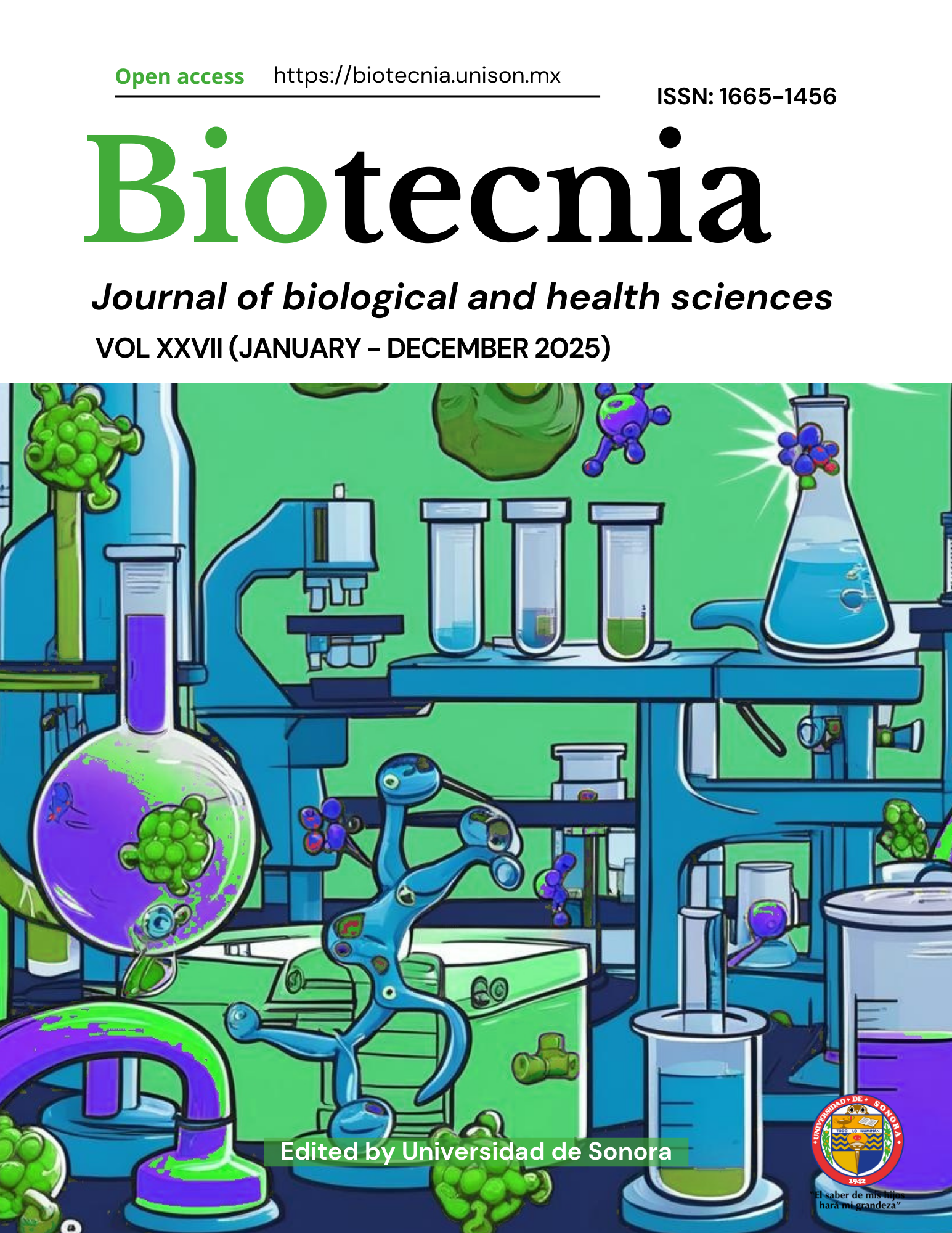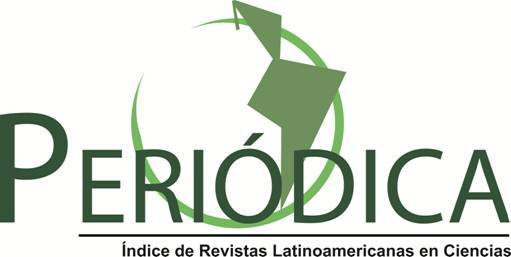Análisis de la vida útil y propiedades nutracéuticas de dos variedades de fresa inoculadas con diversas cepas de Bacillus subtilis
DOI:
https://doi.org/10.18633/biotecnia.v27.2630Palabras clave:
Propiedades físicas, Fresa, Vida de anaquel, Propiedades químicasResumen
El objetivo de este estudio es analizar el efecto sobre las propiedades físicas (forma, tamaño, peso y color), químicas ( Sólidos solubles, acidez titulable y pH), nutracéuticas (ácido ascórbico y antocianinas) y decaimiento de fresas (Fragaria x ananassa) de las variedades Camino Real y Festival al aplicar cuatro tratamientos de cepas de B. subtilis (08, MZ, DN y 06) vs un control (Sin tratamiento) para 5 estados de maduración (Fresas rojas, fresas maduras, fresas rosadas, fresas verdes maduras y fresas verdes); lo anterior con el fin de encontrar los tratamientos que pro-muevan mejoras en los parámetros estudiados. En los resultados encontrados se tiene que en la vida útil para la variedad Camino Real a 28.5 °C el tratamiento 06 reporta un decaimiento de 42.2% menor que el CTL (43.9 %), para 8 °C los tratamientos MZ y DN reportaron un decaimiento de 28.8% que es inferior al CTL (36.1 %); respecto a la variedad Festival a 28.5 °C el tratamiento 06 registro un decaimiento de 41.2 % por debajo de CTL (43.5 %), para 8 °C los tratamientos 08, MZ y DN registran un decaimiento de 27.7 %, 30% y 37.7 % respectivamente, valores inferiores al CTL (46.1 %). Los resultados indican que, al realizar los tratamientos, las propiedades físicas y químicas mejoran o en algunos casos se mantienen iguales a las muestras sin tratamiento, lo que permite dilucidar de manera particular que el tratamiento 06 es el más adecuado a 28.5 °C así como MZ y DN a 8°C para ambas variedades.
Descargas
Citas
A.O.A.C. (Association of Official Analytical Chemist), 1990. OFFICIAL METHODS OF ANALYSIS, https://law.resource.org/pub/us/cfr/ibr/002/aoac.methods.1.1990.pdf
Arangoa J., Rubino M., Aurasa R., Gillett J., Schilderb A. and Grzesiak, A. 2016. Evaluation of chlo-rine dioxide as an antimicrobial against Botrytis cinereain California strawberries. Food Pack-aging and Shelf Life 9:45-54. https://doi.org/10.1016/j.fpsl.2016.05.003
Barkaoui S., Mankai M., Miloud N., Kraïen M., Madureria J., Cabo S., Boudhrioua N. 2021. Effect of gamma radiation coupled to refrigeration on antioxidant capacity, sensory properties and shelf life of strawberries. Food Science and Technology 150: 1-9. https://doi.org/10.1007/s11947-020-02490-1
Barkaoui S., Mankai M., Miloud N., Kraïen M., Madureria J., Cabo S., Boudhrioua N. 2021. E-beam irradiation of strawberries: Investigation of microbiological, physicochemical, sensory acceptance properties and bioactive content. Innovative Food Science and Emerging Technologies 73: 1-10. https://doi.org/10.1016/j.ifset.2021.102769
Bernal F., Orduz-Diaz L., Coy-Barrera E. 2015. Exploitation of the complexation reaction of or-tho-dihydroxylated anthocyanins with aluminum (III) for their quantitative spectrophotometric determination in edible sources. Food Chemistry 185: 84-89. https://doi.org/10.1016/j.foodchem.2015.03.116
Campos V., Rivas B., Pérez M., Figueroa C., Figueroa N., Sanfuentes E. 2017. Thermoplastic starch/claynano composites loaded with essential oil constituents as packaging for strawberries in vivo antimicrobial synergy over Botrytis cinerea. Phostarvest Biology and Technology 129: 29-36. https://doi.org/10.1016/j.postharvbio.2017.03.005
Cano M. 2013. Biological strategies for disease management in strawberry growing (Fragaria spp.). Revista colombiana de ciencias hortícolas 7: 263-276. http://www.scielo.org.co/scielo.php?script=sci_abstract&pid=S2011-21732013000200011
Castañeda E. and Ligia C. 2016. Evaluation of growth of four species of the genus Bacillus sp., the first step to understand their biocontrol effect on Fusarium sp. NOVA 12: 53-65. http://www.scielo.org.co/scielo.php?script=sci_abstract&pid=S1794-24702016000200006&lng=e&nrm=iso&tlng=en
Cubero-Cardoso J., Serrano A., Trujillo-Reyes A., Villa-Gómez D., Borja R., Fermoso F. 2020 Valo-rization Options of Strawberry Extrudate Agro-Waste. A Review. IntechOpen 1:1-20. DOI: 10.5772/intechopen.93997
Daubeny H. 1980. Red raspberry cultivar development in British Columbia with special reference to pest response and germplasm exploitation. Acta hort 112: 59-67. https://agris.fao.org/agris-search/search.do?recordID=XE8181600
Dikshit R., Tallapragada P. 2018. Comparative Study of Natural and Artificial Flavoring Agents and Dyes. Natural and Artificial Flavoring Agents and Food Dyes 1: 83-111. 10.1016/B978-0-12-811518-3.00003-X
FAO. (The Food and Agriculture Organization), 2020. FAOSTAT BASE DE DATOS ESTADÍSTI-COS, https://www.fao.org/faostat/es/#data
Farran A., Zamora R., and Cervera P. 2013. Tabla de composición de alimentos del CESNID. Editorial Universitat de Barcelona, S.A.U. 1 p. https://www.sennutricion.org/es/2013/05/13/tablas-de-composicin-de-alimentos-del-cesnid
Filho M., Zacchi C., Henriques S., Gomes C., Ibrahim P., Della S. 2018. Physicochemical, microbio-logical and sensory acceptance alterations of strawberries caused by gamma radiation and storage time. Scientia Horticulturae 238: 187-194. https://doi.org/10.1016/j.scienta.2018.04.053
Forges M., Vàsqueza H., Charlesa F., Chabane D., Urbana L., Lizzia Y., Bardinb M., Aarroufa J. 2018. Impact of UV-C radiation on the sensitivity of three strawberry plantcultivars (Fragaria x ana-nassa) againstBotrytis cinérea. Scientia Horticulturaejournal 240: 603-613. https://doi.org/10.1016/j.scienta.2018.06.063
García-Vaquero M., Rajuria G. 2018. Analytical Techniques for Phytochemical Estimation in Fruit Juices. Fruit Juices 1: 669-693. https://doi.org/10.1016/B978-0-12-802230-6.00033-3
Hafizur M., Nazmul M., Zaved. 2021. Study on different nano fertilizers influencing the growth, proximate composition and antioxidant properties of strawberry fruits. Journal of Agriculture and Food Research 6:1-5. https://doi.org/10.1016/j.jafr.2021.100246
Hongtao S., Yingying W., Xingxing W., Congmin X., and Xingfeng S. 2019. The marine yeast Sporidiobolus pararoseus ZMY-1 has antagonistic properties against Botrytis cinerea in vitro and in strawberry fruit. Postharvest Biology and Technology 150: 1-8. https://doi.org/10.1016/j.postharvbio.2018.12.009
Khoo H., Aslan A., Tang S., Lim S. 2017. Anthocyanidins and anthocyanins: colored pigments as food, pharmaceutical ingredients, and the potential health benefits. Food and Nutrition 61:1-21. 10.1080/16546628.2017.1361779
Lin M. and Nay Z. 2018. A simple and efficient method for automatic strawberry shape and size es-timation and classification. Biosystems Engineering 170: 96-107. https://doi.org/10.1016/j.biosystemseng.2018.04.004
Miller D. and Liu T. 2014. Antioxidants and Phytochemicals. Reference Module in Biomedical Sci-ences 1 p. https://doi.org/10.1016/B978-0-12-801238-3.00236-1
Navarro C. and Muñoz-Garmendia F. 2015. Desarrollo y caracterización de herramientas genómicas en fragaria diploide para la mejora del cultivo de fresa, Universidad Autonoma de Barcelona 1 p. https://www.tesisenred.net/handle/10803/42009
NMX-FF-062-SCFI-2002. 2002. Productos alimenticios no industrializados para consumo humano - fruta fresca - fresa (Fragaria x ananassa, Dutch) –especificaciones y método de prueba. https://caisatech.net/uploads/XXI_2_MXD_C107_NMX-FF-062-SCFI-2002_R0_9AGO2002.pdf
Pausen E., Barrio S., Lema P. 2021. Production of packaged ready – to – eat whole strawberries (cv. San Andreas): Packaging conditions for shelf-life extensión. Food Packaging and Shelf Life 29: 1-10. https://doi.org/10.1016/j.fpsl.2021.100696
Peng J., Cong Z., Yu-ping H., Xiao-li W., Zi-sheng L. and Yong-hua Z. 2016. Hot air treatment acti-vates defense responses and induces resistance against Botrytis cinerea in strawberry fruit. Journal of Integrative Agriculture 15: 2658–2665. https://doi.org/10.1016/S2095-3119(16)61387-4
Rahman T., Hasnain M., Islam A. 2021. Food insecurity and mental health of women during COVID-19: Evidence from a developing country.PLoS ONE 16: 1-18 https://doi.org/10.1371/journal.pone.0255392
Reyes F. 2012. Análisis de la vida de anaquel y de algunas propiedades nutraceúticas de fresas ino-culadas con diferentes cepas de Bacillus subtilis. Universidad de Guanajuato 1 p.
Romero A., Contigiani E., González H. Alzamora S., Gómez P and Raffellinid S. 2019. Botrytis cinerea response to pulsed light: Cultivability, physiological state, ultrastructure and growth ability on strawberry fruit. International Journal of Food Microbiology 309:1-8. https://doi.org/10.1016/j.ijfoodmicro.2019.108311
Saleh. I., Abu-Dieyeh. 2022. Novel Prosopis juliflora leaf ethanolic extract coating for extending postharvest shelf-life of strawberries . Food Control 133: 1-10. https://doi.org/10.1016/j.foodcont.2021.108641
Torres-García, J.R., Leonardo-Elias, A., Angoa-Pérez, M.V., VillarLuna, E., Arías-Mártinez, S., Oyoque-Salcedo, G. and OregelZamudio, E. 2024. Bacillus subtilis edible films for strawberry preservation: Antifungal Efficacy and Quality at Varied temperatures. Foods 13: 980. https://doi.org/10.3390/foods13070980
Yang, W., Wang, M., Wang, H., Zhang, C., Zhang, Q. and Xiao,H. 2024. Exploitation of the biocontrol potential of amarine-derived Bacillus velezensis and its application onpostharvest strawberry. Food Control 161: 110311 https://doi.org/10.1016/j.foodcont.2024.110311
Descargas
Publicado
Cómo citar
Número
Sección
Licencia
Derechos de autor 2025

Esta obra está bajo una licencia internacional Creative Commons Atribución-NoComercial-CompartirIgual 4.0.
La revista Biotecnia se encuentra bajo la licencia Atribución-NoComercial-CompartirIgual 4.0 Internacional (CC BY-NC-SA 4.0)










_(2).jpg)






